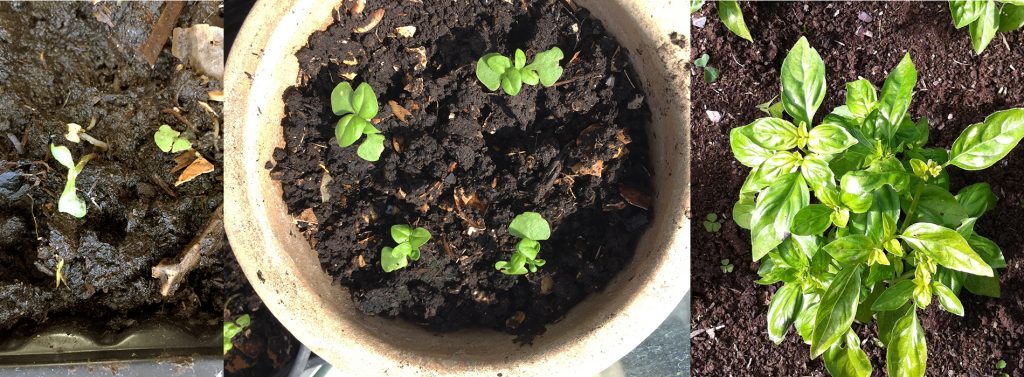I’d planted a series of vegetables and most things were doing well. I was pleased. Yet soon it became clear that the sweet basil was not thriving.
For me basil is often a difficult crop. But I grow it because it adds such marvellous flavour to tomatoes. Just the smell of basil reminds me of Mediterranean holidays. And, like all herbs, basil contains many useful nutrients. I’m guessing the salty and tangy flavour comes from the high levels of iron and potassium that the plant possesses (not to mention vitamins K, A and C).
Until this year I’ve not known why the seeds so often falter. Now, of course, I have plenty of time to inspect my seedlings. The basil seedlings grew strongly, they produced their twin cotillion leaves – and then they just sat there. They were regularly watered, they looked strong – but no new shoots appeared.
For those of you who are novices to growing seeds, I should point out that it is best to wait until the second pair of leaves emerge before transplanting. The first pair exist in embryonic form within the seed, along with the root. Once the first leaves start to photosynthesise, the plant is gaining enough energy from the sun to start making roots of its own, as well as new leaves. The second leaves will be true leaves. These look like the plants mature leaves, are an indication that the seed has taken – that we can start to transplant.
It was probably 7 or ten days before I really inspected the seed tray carefully enough to see exactly what was happening. I discovered that the second leaves had in fact arrived, but had been instantly nibbled by slugs. There’s a rather bad photo of one nibbled seedling above left. An inspection under the seed tray revealed three or four of the culprits, which were unceremoniously despatched.
Strangely the slugs had not shown much interest in the first (cotillion) leaves. I wonder if they taste different. None of the tiny seedlings had died. After the slugs had been apprehended, I waited a day or two more and lo! new sets of true leaves had started growing strongly.
Gardeners often pinch out the growing tip of a young seedling anyway, to encourage bushy growth. My slugs had simply done the job for me! If I had not looked closely, I may well have jettisoned the whole tray. Instead I now have a string of healthy specimens all potted up and sitting in the greenhouse.
This lockdown has forced me to live a slower life. I think we are all noticing the birdsong now, or scrutinising the night sky or enjoying cloud formations.
WH Davies observes in his 1911 poem, ‘Leisure’,
What is this life if, full of care,
We have no time to stand and stare.
At the moment I have plenty of time to stand and stare. It should be one of the activities we can treasure at this time.
Seeing things closely might be interpreted as a form of short-sightedness. You have to get close to appreciate what’s going on, but then you might miss context – the bigger picture. At a time when closeness to the rest of the human race isn’t on the agenda, I’m making do with getting up close and personal with my seedlings. I think we are both benefitting.
The image shows the nibbled seedlings, then the transplanted, re-invigorated seedlings displaying their new growth and finally, on the right, a fine example of basil planted out in open ground that I spotted back in 2012 in the garden of Knightshayes.
Due to family duties I’m not doing long clinical nutrition blogs at the moment. If you want to know about eating healthily during this lockdown go to:
Nutrition for fever and resilience can help fight coronavirus COVID19
and
Stay safe!
